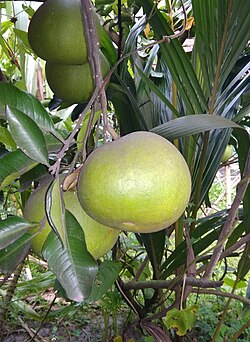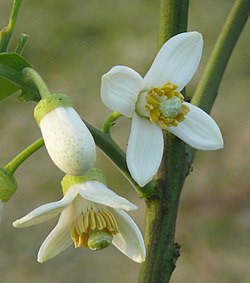Pomelo
| Pomelo | |
|---|---|

| |

| |
| Scientific classification | |
| : | [[Template:Taxonomy/Citrus]] |
| Species: | Template:Taxonomy/CitrusC. maxima
|
| Binomial name | |
| Template:Taxonomy/CitrusCitrus maxima | |

The pomelo (/ˈpɒmɪloʊ, ˈpʌm-/ POM-il-oh, PUM-;[2][3] Citrus maxima) is the largest citrus fruit from the family Rutaceae and the principal ancestor of the grapefruit.[4] It is a natural, non-hybrid, citrus fruit, native to Southeast Asia.[4] Similar in taste to a sweet grapefruit, the pomelo is commonly consumed and used for festive occasions throughout Southeast Asia. As with the grapefruit, phytochemicals in the pomelo have the potential for drug interactions.
Etymology and common names[edit]
According to the Oxford English Dictionary, the etymology of the word "pomelo" is uncertain.[5] It may be derived from Dutch pompelmoes.[4] Its botanical name, Citrus maxima, means "the biggest citrus". In English, the word "pomelo" (also spelt pummelo, pumelo, pomello, pommelo) has become the more common name, although "pomelo" has historically been used for grapefruit.
After introduction to Barbados by 'Captain Shaddock' of the East India Company (apparently Philip Chaddock, who visited the island in the late 1640s[6]), the fruit was called "shaddock" in English.[7][8] From there the name spread to Jamaica in 1696.[9] The fruit is also known as jabong in Hawaii and jambola in varieties of English spoken in South Asia.[4] In Nepali, it is known as "bhogate".[10] In India, it is known as chakota in Kannada, and robab tenga in Assamese.
Description and uses[edit]
The pomelo tree may be 5–15 meters (16–50 feet) tall, possibly with a crooked trunk 10–30 centimeters (4–12 inches) thick, and low-hanging, irregular branches.[4] Leaf petioles are distinctly winged, with alternate, ovate or elliptic shapes 5–20 cm (2–8 in) long, with a leathery, dull green upper layer, and hairy underleaf.[4] The flowers — single or in clusters — are fragrant and yellow-white in color.[4]
The fruit is large, 15–25 cm (6–10 in) in diameter,[11] usually weighing 1–2 kilograms (2–4 pounds). It has a thicker rind than a grapefruit,[4] and is divided into 11 to 18 segments. The flesh tastes like a mild grapefruit, with little of its common bitterness (the grapefruit is a hybrid of the pomelo and the orange).[4][12] The enveloping membranes around the segments are chewy and bitter, considered inedible, and usually discarded.[4] There are at least sixty varieties.[13] The fruit generally contains few, relatively large seeds, but some varieties have numerous seeds.[4]
The juice is regarded as delicious, and the rind is used to make preserves or may be candied.[4] In Brazil, the thick skin may be used for making a sweet conserve, while the spongy pith of the rind is discarded. In Sri Lanka, it is often eaten as a dessert, sometimes sprinkled with sugar. In large parts of Southeast Asia where pomelo is native, it is commonly eaten as a dessert, often sprinkled with salt or dipped in a salt mixture, but it may instead be made into salads.[4] In the Philippines, a pink beverage is made from pomelo and pineapple juice.[14]
The fruit may have been introduced to China around 100 BCE.[4] In East Asia, especially in Cantonese cuisine, braised pomelo pith is used to make dishes that are high in fibre and low in fat.[15]
Propagation and genetic diversity[edit]
The seeds of the pomelo are monoembryonic, producing seedlings with genes from both parents, but they are usually similar to the tree they grow on and therefore pomelo is typically grown from seed in Asia.[4] Seeds can be stored for 80 days at a temperature of 5 °C (41 °F) and with moderate relative humidity.[4] Citrus maxima is usually grafted onto other citrus rootstocks outside Asia to produce trees that are identical to the parent; high-quality varieties are propagated by air-layering or by budding onto favored rootstocks.[4]
The physical and chemical characteristics of pomelo vary widely across South Asia.[4]
Varieties[edit]
Non-hybrid pomelos[edit]
Possible non-hybrid pomelos[edit]
Hybrids[edit]
The pomelo is one of the original citrus species from which cultivated citrus fruits have been hybridized, others being citron, mandarin, and to a lesser extent, papedas and kumquat. In particular, the common orange is presumed to be a naturally occurring hybrid between the pomelo and the mandarin with the pomelo providing the larger size and greater firmness. The grapefruit was originally also presumed to be a naturally occurring hybrid of the pomelo and the mandarin; however, genome analysis conducted more than two centuries after this presumption was made shows that it is actually a backcrossed hybrid between a pomelo and a sweet orange which is why 63% of the grapefruit's genome comes from the pomelo. [16]
The pomelo is employed today in artificial breeding programs:
- The common sweet orange (Citrus × sinensis) is a pomelo × mandarin hybrid
- The bitter orange (Citrus × aurantium) is another pomelo × mandarin hybrid
- The tangelo is a hybrid between pomelo or grapefruit and any tangerine; it generally has a thicker skin than a tangerine and is less sweet
- 'K–Early' ('Sunrise Tangelo')[17]
- 'Minneola tangelo': Bowen grapefruit × Dancy tangerine[17]
- 'Orlando' (formerly 'Take'): Bowen grapefruit × Dancy tangerine (pollen parent)[17]
- 'Seminole': Bowen grapefruit × Dancy tangerine[17]
- 'Thornton': tangerine × grapefruit, unspecified[17]
- 'Ugli fruit' (Jamaican tangelo): mandarin × grapefruit, probable (wild seedling)[17]
- Grapefruit is a pomelo backcross: pomelo × sweet orange (see above)
- Forbidden fruit: another Caribbean pomelo/sweet orange cross
- 'Nova': Clementine × Orlando tangelo cross[17]
- The Oroblanco and Melogold grapefruits are hybrids between Citrus maxima and the grapefruit
- Mandelos: pomelo × mandarin
- Mato buntan: a variety in Taiwan[18]
- Hyuganatsu is a pomelo hybrid
- Kawachi Bankan: ujukitsu x unidentified
Nutrition[edit]
Template:Nutritional value Raw pomelo flesh is 89% water, 10% carbohydrates, 1% protein, and contains negligible fat (table). A 100-gram reference amount provides 159 kilojoules (38 kilocalories) of food energy, and is rich in vitamin C (73% of the Daily Value), with no other micronutrients in significant content (table).
Potential for drug interaction[edit]
Pomelo may cause adverse effects, similar to those caused by grapefruit and some other citrus fruits, through the inhibition of cytochrome P450-mediated metabolism of prescription drugs such as anti-hypertensives and anticoagulants.[19]
Gallery[edit]
This white hybrid Pomelo is cushioned with a thick mesocarp layer
Pink pomelo juice vesicles
Fujian's Pinghe County is famous in China for its pomelos
Closeup of pomelo petiole
Ipoh pomelos on sale at Chinatown, Singapore
References[edit]
- ↑ Botanic Gardens Conservation International (BGCI).; IUCN SSC Global Tree Specialist Group (2019). "Citrus maxima". IUCN Red List of Threatened Species. 2019: e.T62042732A147027490. doi:10.2305/IUCN.UK.2019-2.RLTS.T62042732A147027490.en. Retrieved 19 November 2021.
- ↑ "pomelo". The Chambers Dictionary (9th ed.). Chambers. 2003. ISBN 0-550-10105-5.
- ↑ Template:Cite Merriam-Webster
- ↑ 4.00 4.01 4.02 4.03 4.04 4.05 4.06 4.07 4.08 4.09 4.10 4.11 4.12 4.13 4.14 4.15 4.16 4.17 Morton, Julia F. (1987). "Pummelo: Citrus maxima". Fruits of warm climates. NewCROP, New Crop Resource Online Program, Center for New Crops and Plant Products, Purdue University. pp. 147–151. Retrieved 31 January 2020 – via purdue.edu.
- ↑ "pomelo". Oxford English Dictionary (Online ed.). Oxford University Press. Template:OEDsub
- ↑ Kumamoto, J; Scora, R W; Lawton, H W; Clerx, W A (1987). "Mystery of the Forbidden Fruit: Historical Epilogue on the Origin of the Grapefruit, Citrus paradisi (Rutaceae)". Economic Botany. 41: 97–107. doi:10.1007/BF02859356. S2CID 42178548.
- ↑ "Pomelo (Pummelo) Citrus maxima". Citruspages.free.fr. 2009-11-14. Retrieved 2020-07-06.
- ↑ "fruitInfo-trdLevel2021.html". Itfnet.org. 2008-06-12. Retrieved 2020-07-06.
- ↑ American Heritage Dictionary, 1973.
- ↑ "The Joys of Bhogate Sadheko". ECS NEPAL. Retrieved 2021-05-13.
- ↑ "Pomelo: Growing the granddaddy of grapefruit", SFGate.com, December 25, 2004
- ↑ Morton, Julia F. (1987). "Grapefruit: Citrus paradisi". Fruits of warm climates. NewCROP, New Crop Resource Online Program, Center for New Crops and Plant Products, Purdue University. pp. 152–158. Retrieved 31 January 2020 – via purdue.edu.
- ↑ Pomelos, grapefruit's sweeter and mellower relative, have a wealth of flavor, by Jeanne Kelley, in the Los Angeles Times; published February 12, 2016; retrieved November 19, 2021 (via archive.org)
- ↑ Hargreaves, Dorothy; Hargreaves, Bob (1970). Tropical Trees of the Pacific. Kailua, Hawaii: Hargreaves. p. 51.
- ↑ "Braised pomelo pith". Week in China. 8 December 2017. Retrieved 22 August 2020.
- ↑ "Grapefruit: History, Use, and Breeding in: HortTechnology Volume 31 Issue 3 (2021)". Journals.ashs.org. Retrieved 2022-05-01.
- ↑ 17.0 17.1 17.2 17.3 17.4 17.5 17.6 Morton, Julia F. (1987). "Tangelo". Fruits of warm climates. Miami, FL.: Julia F. Morton. pp. 158–160. ISBN 0-9610184-1-0.
- ↑ "Mato buntan". University of California - Riverside, Citrus Variety Collection. Retrieved 2022-03-12.
- ↑ Bailey, D. G.; Dresser, G.; Arnold, J. M. O. (2012-11-26). "Grapefruit-medication interactions: Forbidden fruit or avoidable consequences?". Canadian Medical Association Journal. 185 (4): 309–316. doi:10.1503/cmaj.120951. ISSN 0820-3946. PMC 3589309. PMID 23184849.


















